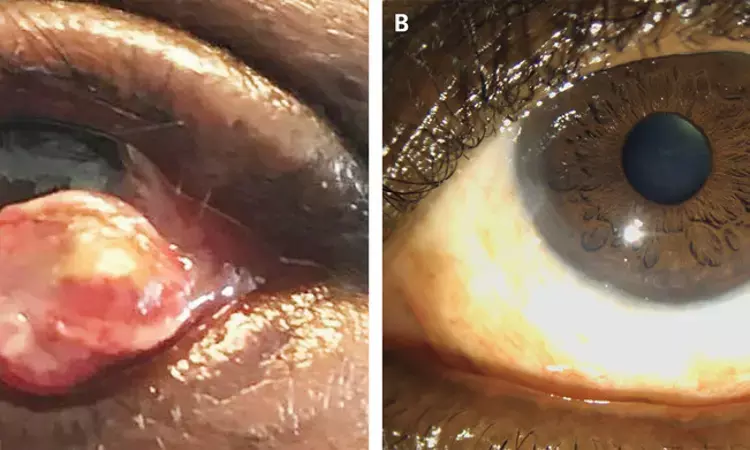- Home
- Medical news & Guidelines
- Anesthesiology
- Cardiology and CTVS
- Critical Care
- Dentistry
- Dermatology
- Diabetes and Endocrinology
- ENT
- Gastroenterology
- Medicine
- Nephrology
- Neurology
- Obstretics-Gynaecology
- Oncology
- Ophthalmology
- Orthopaedics
- Pediatrics-Neonatology
- Psychiatry
- Pulmonology
- Radiology
- Surgery
- Urology
- Laboratory Medicine
- Diet
- Nursing
- Paramedical
- Physiotherapy
- Health news
- Fact Check
- Bone Health Fact Check
- Brain Health Fact Check
- Cancer Related Fact Check
- Child Care Fact Check
- Dental and oral health fact check
- Diabetes and metabolic health fact check
- Diet and Nutrition Fact Check
- Eye and ENT Care Fact Check
- Fitness fact check
- Gut health fact check
- Heart health fact check
- Kidney health fact check
- Medical education fact check
- Men's health fact check
- Respiratory fact check
- Skin and hair care fact check
- Vaccine and Immunization fact check
- Women's health fact check
- AYUSH
- State News
- Andaman and Nicobar Islands
- Andhra Pradesh
- Arunachal Pradesh
- Assam
- Bihar
- Chandigarh
- Chattisgarh
- Dadra and Nagar Haveli
- Daman and Diu
- Delhi
- Goa
- Gujarat
- Haryana
- Himachal Pradesh
- Jammu & Kashmir
- Jharkhand
- Karnataka
- Kerala
- Ladakh
- Lakshadweep
- Madhya Pradesh
- Maharashtra
- Manipur
- Meghalaya
- Mizoram
- Nagaland
- Odisha
- Puducherry
- Punjab
- Rajasthan
- Sikkim
- Tamil Nadu
- Telangana
- Tripura
- Uttar Pradesh
- Uttrakhand
- West Bengal
- Medical Education
- Industry
Case of conjunctival Kaposi's Sarcoma reported in NEJM

Courtesy NEJM
Dr Filipe Gouveia-Moraes and Dr Nuno Campos, at Hospital Garcia de Orta, Almada, Portugal have reported a rare case of congenital Kaposi sarcoma that has been published in the New England journal of Medicine.
Kaposi sarcoma (KS) is a vascular spindle cell tumor of endothelial cell origin which can present in the skin, viscera, or mucosa and find its name as it was first described in 1872 by Dr. Moritz Kaposi.Conjunctival Kaposi's sarcoma (KS) is a red to pink conjunctival tumor and a blue to purple eyelid tumor. It is typically found in patients with HIV acquired immunodeficiency syndrome (AIDS), but can occur in the elderly and immunocompromised patients like transplant patients. Classic Kaposi's sarcoma when occurs in the elderly is slowly progressive.
Conjunctival or adnexal Kaposi sarcoma is not commonly encountered by healthcare providers since the advent of highly active antiretroviral therapy. It is vital for all healthcare providers to have Kaposi sarcoma in the differential diagnosis of a hemorrhagic conjunctival or adnexal mass and be familiar with its association with HIV/AIDS. If suspected, appropriate counseling and testing should be performed.
According to history a 50-year-old man presented to the ophthalmology clinic with a large lesion on his left eye that had developed over the preceding month. Physical examination showed a red, mobile, nodular mass on the inferior bulbar conjunctiva and violaceous plaques on the patient's back and lower limbs.
Antibody testing for human immunodeficiency virus (HIV) type 1 was positive. The viral load was 147,000 copies per milliliter (reference range, <40), and the CD4 cell count was 116 per cubic millimeter (reference range, 500 to 1200).
A biopsy specimen of the skin showed a spindle-cell neoplasm, and immunohistochemical testing for human herpesvirus 8 was positive. These findings were consistent with Kaposi's sarcoma, a malignant vascular neoplasm that is related to human herpesvirus 8 infection and that typically occurs in patients with immunodeficiency.
Rapidly enlarging vascular or bleeding lesions in the eye in a patient with HIV infection should alert physicians to a possible diagnosis of conjunctival Kaposi's sarcoma. Antiretroviral therapy and doxorubicin were initiated. Five months after presentation, the conjunctival mass had resolved (Panel B), as had the skin lesions.
DOI: 10.1056/NEJMicm2105217
Hina Zahid Joined Medical Dialogue in 2017 with a passion to work as a Reporter. She coordinates with various national and international journals and association and covers all the stories related to Medical guidelines, Medical Journals, rare medical surgeries as well as all the updates in the medical field. Email: editorial@medicaldialogues.in. Contact no. 011-43720751
Dr Kamal Kant Kohli-MBBS, DTCD- a chest specialist with more than 30 years of practice and a flair for writing clinical articles, Dr Kamal Kant Kohli joined Medical Dialogues as a Chief Editor of Medical News. Besides writing articles, as an editor, he proofreads and verifies all the medical content published on Medical Dialogues including those coming from journals, studies,medical conferences,guidelines etc. Email: drkohli@medicaldialogues.in. Contact no. 011-43720751


